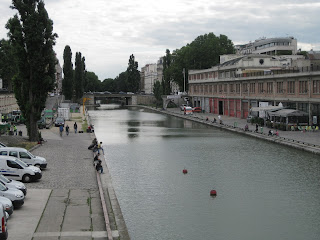One of the great things about this Paris holiday is how Allison and I have tried
to stay away from the more touristy areas. Not all the time admittedly – we’ve queued
with half of Paris to see Monet’s Water Lilies at the Musée de
l’Orangerie, got overcharged for water in a café in the Tuileries and got
trampled by camera-wielding tourists in Montmartre .
To counter this, we have been renting an apartment in the
non-touristy 12th arrondissement where we are self-catering with food
purchased in the local markets. We have gone out of our way to speak en francais wherever possible, although
in one bar I was told by the (American) barmaid that I could use English if I
wanted to.
A people-watching game that we’ve enjoyed playing on this
trip has been ‘Parisian or tourist’, where we try to guess whether a random
passer-by is a local or here on holiday. In some cafés, the couple at the next
table have made it too easy for us by ordering their drinks in very loud English.
Sometimes they even have a bratty child in tow. We have learned that in cafés
like this you have to specify l’eau
du robinet (tap water) in order to avoid being overcharged – lesson
learned!
This afternoon, we decided to leave those sorts of places
behind and spend our last full day in Paris
walking along the Canal St-Martin. It’s one of the more trendy parts of Paris these days, but
it’s largely escaped the attention of the tourist industry. In fact, it’s not a
part of town either of us had really heard of – we were tipped off by an
article in the Toronto Star which
highlighted it as a part of Paris
that is very much off the beaten track.
To get there, we took the Metro to the Place de la Bataille
de Stalingrad , located just north of the Gares
du Nord and de l’Est. Our first impression, after we’d managed to find our way
out of the maze that is Stalingrad station,
was that we’d stumbled on a rough part of town. The walls were covered in
graffiti, and there were groups of suspicious-looking young men hanging around
along the towpath. The shirtless men doing chin-ups on a climbing-frame were
unnerving, to say nothing of the homeless guys with their pit-bulls. Not an
area in which you’d want to flaunt your digital SLR.
At one time in the not-so distant past, the whole area was
infamous for drug-dealing and the violence that came with it. Just six years
ago, loads of illegal immigrants from Afghanistan camped out here. But
this part of Paris
is undergoing a period of change and is currently experiencing a renaissance.
Cheap rents brought in the students, the artists and the hipsters, and as a
result the area has become fashionable while retaining a lot of its old
character.
The canal itself, built in the 1820s to link the Seine with
a canal network to the north of Paris ,
is very picturesque with its tree-lined locks and a series of wrought-iron
footbridges. For part of the way, the water level is actually higher than the
streets next to it. We’d definitely picked the right day to do this, as it
wasn’t too hot and the rain which we thought was coming in the afternoon failed
to materialise.
Gradually, we left the gangs and the homeless guys behind
and strolled past men reading the papers on benches and small play-areas where
mothers took their young children. Students sat chatting by the water’s edge,
and customers from a couple of bars spilled out onto the towpath. Parisians
sped by on grey Velib’ bikes, which are
everywhere in this city and have revolutionised how people get around (these
have been copied by London with the ‘Boris bikes’).
Our walk along the canal ended near the Place de la
République where the canal goes underground to continue its journey to the Seine . Close to the end, we chanced upon a cool-looking
bar called Chez Prune, where the waiter wasn’t wearing a white shirt and black
waistcoat, didn’t address us in English and sang along to the old song that was
playing on the stereo as he got our order from the bar. What a welcome change!
It’s a world away from the tourist-trap cafés in St-Germain
where people go because the likes of Pablo Picasso and Jean-Paul Sartre used to
hang out there. To be honest, if Sartre were around today, I reckon Chez Prune
is the sort of place where he’d be doing his thinking.
Around us, there were no loud English-speakers – everyone
was speaking French. This, it seems, is where the locals go for un café or un verre de vin rouge. Any game of ‘Parisian or tourist’, would not
have lasted for very long – in fact, there were only two tourists in the place,
who were working hard not to blow their cover!








No comments:
Post a Comment